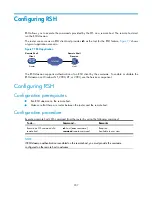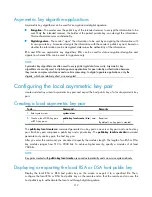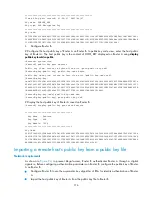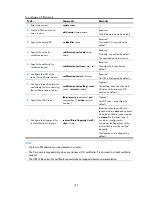
211
Configuring public keys
Asymmetric key algorithm overview
Basic concepts
•
Algorithm
—A set of transformation rules for encryption and decryption.
•
Plain text
—Information without being encrypted.
•
Cipher text
—Encrypted information.
•
Key
—A string of characters that controls the transformation between plain text and cipher text. It is
used in both the encryption and decryption.
Key algorithm types
As shown in
, the information in plain text is encrypted by an algorithm with the help of a key
before being sent. The resulting cipher text is transmitted across the network to the receiver, where it is
decrypted by the same algorithm, also with the help of a key, to obtain the original plain text.
Figure 82
Encryption and decryption
The following types of key algorithms are available, based on whether the keys for encryption and
decryption are the same:
•
Symmetric key algorithm
—The keys for encryption and decryption are the same. Commonly used
symmetric key algorithms include AES and DES.
•
Asymmetric key algorithm
—The keys for encryption and decryption are different; one is the public
key, and the other is the private key. The information encrypted with the public key can only be
decrypted with the corresponding private key, and vice versa. The private key is kept secret, and
the public key may be distributed widely. The private key cannot be practically derived from the
public key.
















































